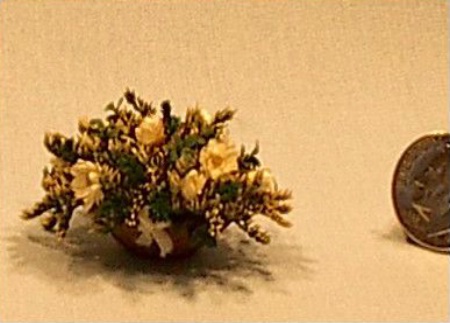
Clysta |
|
Miniature (1:12 or smaller) Dried Flowers
|
|
|
|

test basket yellow.jpg
Photo is yellow, but I shot it on blue cloth
Clysta
|
|
|
|
I'm trying to take pictures of miniature (1:12 or smaller) dried flower arrangements and don't understand the lighting rules, some pictures come out looking like they're in yellow light sort of - I'm shooting them on a light blue cloth with 4 small (20 watts each) halogen lights over the piece, some look the right color and some of the pictures look all yellowish. I truly need help please? Any help would be most appreciated! Thank you, Clysta
May 02, 2001
|
|
|
John A. Lind |
|
Clysta, You didn't state what film you were using, but I'd bet dollars to donuts it's "daylight" balanced. The "halogen" lights are "tungsten." While the light they give off may look white, it's not. Our brains do a marvelous job of color correcting artificial lighting to make it look "whiter" than it really is. Film doesn't. Lamps with tungsten filaments give off much more red/yellow and much less blue than daylight from the sun contains. I would also guess you're using color negative film and looking at the prints from it. If so, the print processor is undoubtedly able to do some color correction with some of the negatives but not all of them. If it's a consumer lab with an automated print machine you can end up "all over the map" with the color correction. Suggestion:
Use some "tungsten" balanced film. They are made for shooting under tungsten studio lights and the halogens you are using are very close to their color balance. These will be professional films and you will have to buy them at a camera store that carries pro films. The numbers are the film speeds. For color negative (prints):
Kodak Portra 100T
Fuji Fujicolor NPL 160 For transparency (slides):
Kodak EPY-64
Kodak EPT-160
Kodak EPJ-320
Fuji Fujichrome 64T Type II You might try one of the negative films first and do the shoot just as you did before. You will probably find a huge difference in the result. Yes, there is a way to balance daylight to tungsten lighting using a filter. However, it is a very dark blue, creates a very dark viewfinder, it's hard to compose and focus with it, and it exacts a huge cost in loss of light. This effectively makes the required exposures as if you are using a very slow film. Use tungsten balanced film if at all possible! -- John
May 01, 2001
|
|
|
John A. Lind |
|
Oops... left out one more thing... The color negative films I listed are C-41 process, just like daylight color negative films. This means the film can be developed and printed the same as any daylight color negative film. The transparency (slide) films are E-6 process and developing them is the same as for any daylight Ektachrome or Fujichrome. -- John
May 02, 2001
|
|
|
Clysta |
|
Thanks John! I quess you can probably tell that I'm so new at this that I didn't even think to tell you what I was using and for that I apologize! I'm using the Digital HP PhotoSmart hp 315 camera and I'm using just the way it came out of the box, no extra cards or anything else. I'm trying to take the pictures and then load them on my computer (which I'm new also, they both came together) and then upload the pictures to ebay. Does that help? Thank you again, Clysta
May 04, 2001
|
|
|
Don A. Tuleja |
|
Digital cameras are generally balanced for daylight. Therefore, you will either need to use color corrected lighting (Some 5500k flourscent tubes exist and are pretty close, or take the setup outside, or even try a video cam light!)
May 10, 2001
|
|
|
Clysta |
|
I really appreciate you taking the time to help me and will try your suggestions. Thank you, Clysta
May 10, 2001
|
|
|
|
Log in to respond or ask your own question.
|